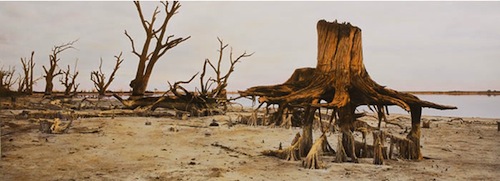Fishes have cross-hatching details
Lin Onus, Guyi Buypuru, 1996. © The Estate of Lin Onus
Having not being to attend the lecture and tutorial in week
4, I thought that it would be good for me to catch up on what I missed. I read
the article about “Lin Onus: Picturing histories speaking politics,” over
again, looked on the Internet for some Yvonne Koolmatrie artworks and this time
tried to answer the tutorial questions by myself. While it was different
answering the questions on my own and not hearing other people’s point of view,
it really did get me thinking and reflect on the things I’ve learned so far.
So..here we go…
Yvonne Koolmatrie, Bi-plane, 1994. © National Gallery of Australia
When you look at Lin Onus and Yvonne Koolmatrie artworks,
you can immediately notice that they have such a distinguished visual language
and style. It’s quite different to what we have come to known as traditional
Aboriginal art. Instead, these two artists combine the traditional and the
contemporary together and by doing so they reveal a different side to
Aboriginal art. I really believe that their works are about the reinvention of
culture instead about the loss of it because their artworks, as you can see,
still revolve around the same beliefs and represent the very same culture. The
essence has not changed while the form may be different. Even having the
symbolisms of traditional practices such as weaving and the cross hatching
within this contemporary looking artworks, I think reveals that it’s certainly
not lost but very much alive. I believe in fact that it highlights the exact
opposite.
Thinking back on past tutorial discussions from the second
week, I think we have already come across this issue about whether the changes
happening to Aboriginal art – of it transforming “away” from its traditional
form means that it is less authentic or that culture is lost. However, how can
culture be lost or how is it less authentic when the essence of the artworks is
still very much the same? Only the surface is different - the way that it is
represented. Is it because we have been too accustomed to seeing Aboriginal art
in its “traditional form” that we limit ourselves in seeing it in different
ways and thus consider it to be less authentic? However, I think like any other
artist or forms of art, people’s style and way of representation will always
evolve over time. As a non-Aboriginal person, I also think that it should be
the right or it is the Aboriginal artist’s part in having the choice to define
their own culture, instead of non-Aboriginal people doing that for them.
Any ways, while this topic of authenticity and progress of
Aboriginal art seems interesting, I’ll reserve that for another post before I
start going off track. So going back to the tutorial question…I think by using
the traditional forms like the weaving and cross hatching in the contemporary
urban context, it really brings Aboriginal culture to live by creating a link
between the past and the present. Aboriginal culture is alive and it's real. It shows that Aboriginal culture is not
something in the past or an old, ancient culture but it still exists and lives
today within our very own society. I think it really does highlight the continuity
of the Aboriginal culture and beliefs.















 by
by 








